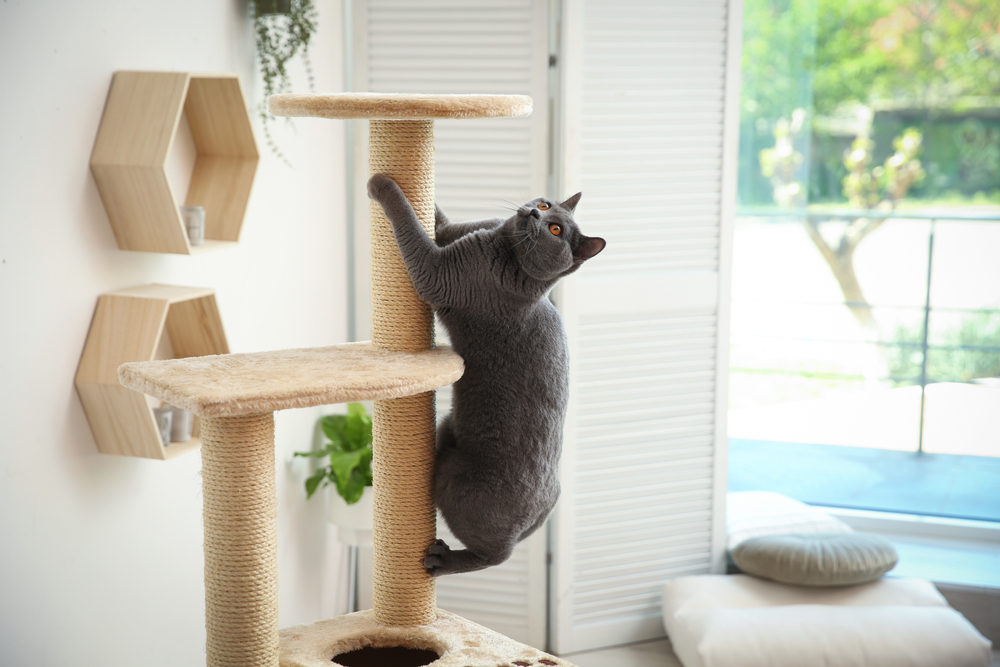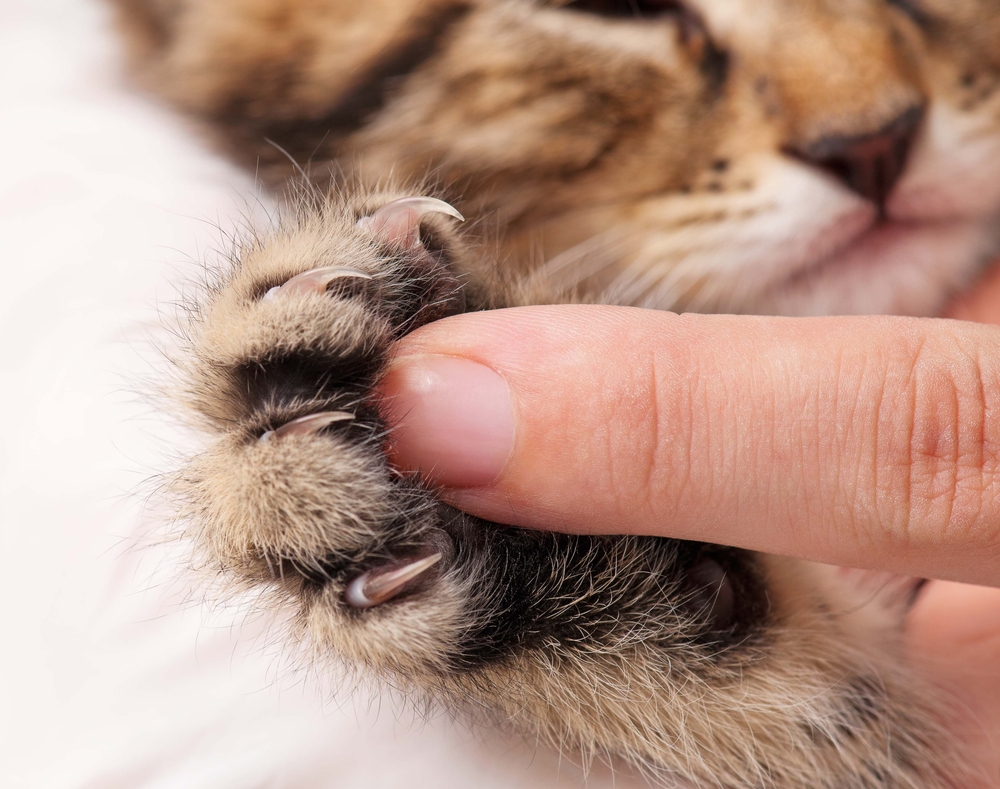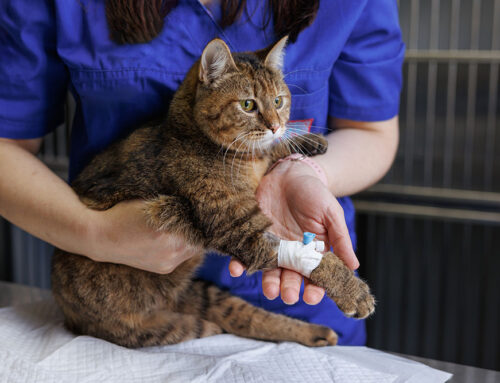Some cat owners consider declawing their cat to prevent furniture damage, but the procedure impedes normal instinctual feline behaviors, and can cause long-lasting adverse habits and health complications. By answering your most frequently asked questions about declawing, our Memorial Villages Animal Hospital team sets the record straight on cat scratching, the declawing procedure, and acceptable scratching alternatives to offer your sweet kitty.
Question: Why do cats scratch?
Answer: Scratching is an instinctual feline behavior, and cats scratch for multiple reasons, including:
- Nail maintenance — Scratching loosens and removes dead nail tissue, helping to keep your cat’s claws clean and sharp.
- Stretching — Scratching helps your cat stretch their spine, limbs, and paws.
- Communication — Cats scratch to communicate with other cats. When your cat scratches, they leave behind scent from glands between their toes, leaving a message for other cats in the area.
Q: What is a cat declaw procedure?
A: A cat declaw is a serious procedure. To prevent the claw regrowth, the veterinarian amputates a cat’s toes at the first joint. Therefore, a cat declaw involves 10 amputations if only their front claws are removed, and 18 amputations if their back claws are also removed. A declawed cat then walks and runs on their vulnerable incision sites, which are also exposed to urine, feces, and gritty litter when they eliminate. Declawed cats can experience numerous long-term behavioral and health complications, including:
- Paw pain — The initial surgery is painful for cats, and many experience chronic paw pain that never resolves.
- Back pain — Many declawed cats experience back pain, because they must modify their gait to compensate for their missing toe joints.
- Inappropriate elimination — Declawed cats are about seven times more likely to eliminate in inappropriate places. This may be because the hard, gritty litter is painful to their sensitive feet, causing them to seek a less painful alternative.
- Disrupted balance — Cats are digitigrade walkers (i.e., walk on their toes). A declawed cat must alter the way they walk, which greatly affects their balance.
- Overgrooming — In response to the amputation procedure’s stress and the resulting pain, declawed cats frequently overgroom.
- Aggression — Because they feel defenseless without their claws, declawed cats are more likely to exhibit aggression toward humans and other pets.
Q: What are alternatives to declawing my cat?
A: Cats’ scratching can be extremely destructive, damaging furniture, carpet, drapes, and—sometimes—you. To help mitigate these problems, declawing alternatives are available, including:
- Trimming your cat’s claws — To keep them an acceptable length—and making them less destructive—trim your cat’s claws every two weeks.
- Providing scratching posts — Because scratching is an instinctual feline behavior, you must provide appropriate areas where your cat is allowed to scratch.
- Training your cat — Use positive reinforcement to train your cat to use their scratching post.
- Using vinyl caps — Glue vinyl caps over your cat’s nails to prevent scratching damage. You can easily apply these caps, which typically remain adhered for six weeks.
Q: How do I trim my cat’s claws?
A: In addition to protecting your furniture and your skin from your cat’s sharp claws, trimming your cat’s nails regularly also prevents painful ingrown nails, which may require veterinary attention. Trim your cat’s claws by doing the following:
- Gather your supplies — Gather an appropriate nail trimmer, cat treats—and your patience.
- Find a comfortable position — Determine the nail-trimming position your cat tolerates best. To control an unruly cat, you may need a helper. If your cat is especially resistant to the nail-trimming procedure, consider wrapping them in a towel, leaving one paw free to be trimmed.
- Isolate the nail — Apply gentle pressure at the base of your cat’s claw to extend the nail.
- Trim the nail — Trim the nail at a 45-degree angle, avoiding the pink area at the nail base. This pink area is the quick, and if you cut the nail too close, your cat will experience painful bleeding.
- Be patient — Cut as many nails at one time as your cat will allow, but be willing to cut their nails in multiple sessions if they become too resistant. Make the nail-trimming experience as positive as possible—for your cat and you.
- Reward your cat — Reward your cat for cooperating after each nail-trimming session by offering your feline friend a high-value treat after each session.
Q: How do I choose the right scratching post for my cat?

A: Scratching posts are available in several configurations and materials. When choosing scratching posts for your cat, consider these factors:
- Number — Ensure each cat in your household has a scratching post, and place the posts throughout your home.
- Stability — Ensure the scratching post is stable, so the structure does not overturn when your cat is scratching.
- Orientation — If your cat tends to scratch your couch or your curtains, they are likely a vertical scratcher, and you should provide a vertical scratching post. If your cat prefers to scratch your carpet, they are likely a horizontal scratcher, and you should provide a horizontal scratching structure. The best option is to provide posts in different orientations, so your cat can scratch as they choose.
- Material — Most cats enjoy sisal scratching surfaces, but—to determine your cat’s preference—also provide cardboard and carpeted scratching structures.
Although their scratching can be destructive, your sweet kitty does not have to undergo a painful declaw procedure when you provide them with appropriate alternatives. If your feline friend is too feisty for you to trim their nails, contact our Memorial Villages Animal Hospital team for help.









Leave A Comment